- Solar energy blog
- Benefits of Agrivoltaics and 5 real-life examples of successful implementations
Benefits of Agrivoltaics and 5 real-life examples of successful implementations


Laura Rodríguez
Business developer
Laura is a renewable and software industry sales professional, currently working at RatedPower as Sales Overlay in North America & Territory Manager Oceania. With a background in International Business and International Trade, Laura previously worked in the business strategy area in various companies as well as as a market analyst for the Government of Spain in Australia.
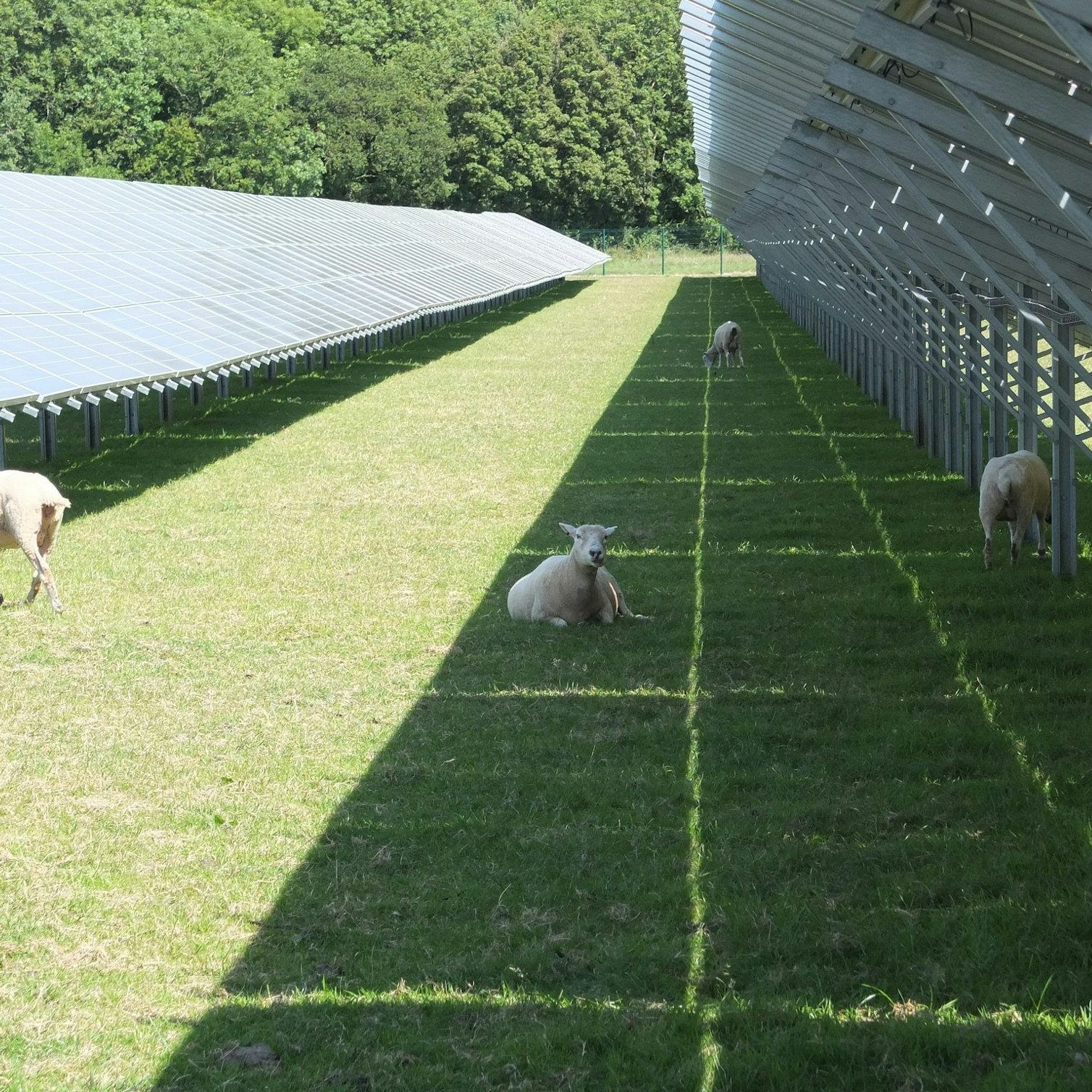
Content
Climate change is shedding light on the vulnerabilities of our food, energy and water systems and the importance of building resilience in renewable energy and food production.
In this context, Agri-Photovoltaics (Agri PV) is increasingly raising interest in the renewable energy and farming community as a solution to both challenges.
Agri PV or Agrivoltaics consists on integrating PV modules above the crops in order to enhance climate resilience and allow sustainable food and energy production on one single piece of land. While in the past it was a question of either food or solar energy production on farmland, Agri PV can combine both successfully as well as achieving greater efficiencies on both activities.
By working together on the same land, farmers and energy developers can realize benefits for all involved while preserving the agricultural character of the state’s rural communities. It’s not an all-or-nothing proposition -
Lexie Hain, executive director of the American Solar Grazing Association

However, as any innovative process, co-locating these activities may face different challenges which are important to address.
The main setbacks, from the agricultural point of view, of combining these activities refer to a lack of light for plants which may translate on a decreased agricultural production. Choosing the technical itineraries and type of crops will be essential for obtaining the best agricultural yields. In this sense, options for crop production beneath the panels are limited to crops typically grown and harvested by hand or with small machinery. According to NREL, shade-loving pollinator crops, bedding plants, nursery crops, and small-statured fruit trees or shrubs are options, in addition to vegetables and small- to medium-size livestock, such as most breeds of cattle and horses of non draft breeds.
“There are a lot of different opportunities for dual-use farming,”
In terms of photovoltaic performance, the key aspect is to be able to engineer the best design that fulfills the crop or livestock farming requirements while at the same time maintaining the costs of the solar plant low enough to be profitable.
Explore how you may design Agri PV plants with RatedPower: take a product tour.
Therefore, analyzing the different crops and livestock options for your land will be the first and most important step when thinking of combining both activities. As an example, when combining sheep farming with solar, the design of the plant does not differ much from a only-solar project. However, combining solar with berries might require taller structures which will need to be more robust to cope with stronger winds and thus affecting directly on the costs of the plant.
In spite of the setbacks, the benefits of co-locating Agri and PV, if the project is properly designed, are considerable. Let’s take a closer look into them.

Benefits of co-locating solar and crop or livestock farming
Benefits to solar developers include:
Reduced installation costs – The use of previously tilled agriculture may prevent the need for expensive grading to flatten land to a usable level.
Increase PV performance – Vegetation under modules can contribute to lower soil temperatures and increase solar performance.
Accelerate the energy transition – by joining forces with the land managers and rural areas, more owners would probably be interested in using their lands for energy purposes too.
Building closer links with the agricultural world – large-scale photovoltaic farms have created a lively controversy in the agricultural world and by adapting to the sector and favouring both activities, the solar industry would see a greater ratio of their project acceptance.
Reduced upfront risk – Geotechnical risks can increase the cost of solar installation due to increased testing needs. Previously tilled agricultural land was identified as the “least risk option” during a series of surveys with solar installers.
Reduced legal risk – By using previously disturbed land, solar installers can reduce the risk of up front litigation during the environmental review process.
Marketing opportunity to a sustainability-minded audience.
Benefits to agricultural land managers include:
Reduced electricity costs – developers and landowners may reach an agreement to allocate a percentage of the generated electricity to the land and/or town.
Diversification of the revenue stream.
Increased ability to install high-value, shade-resistant crops for new markets – The shading by the PV panels provides multiple additive and synergistic benefits, including reduced plant drought stress and more constant temperature as the panel will maintain the temperature higher at night and colder during the day.
Potential to extend growing seasons.
Ability to maintain crop production during solar generation.
Allow for nutrient and land recharge of degraded lands.
Potential for water use reduction.
5 Successful Agri PV implementations
BayWa’s Agri-PV project in the Netherlands
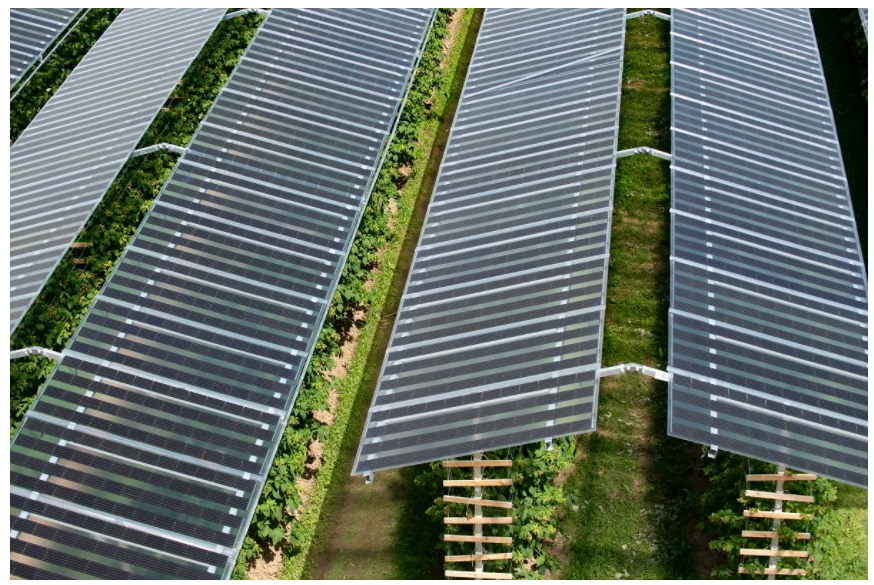
One of BayWa r.e. 's first commercial Agri-PV site in Babberich, the Netherlands. (Source: BayWa r.e.)
To date BayWa r.e. has undertaken several pilot Agri-PV projects across the Netherlands and Germany, which have been helping to deepen the industry’s expertise. These projects focused on wheat, potato, celery, blueberries, red currants, raspberries, strawberries, and blackberries.
Data analysis showed that on hot days, conditions beneath the panels were around two to five degrees cooler than traditional growing methods. This brings significant benefits; less heat stress and evaporation from the soil reduces water demand. Additionally, at night, heat got retained even better than under the plastic coverings farmers currently use to protect berries from the cold (which could potentially decrease the use of plastic in farms).

Crops grown underneath the panels at BayWa r.e.’s sites include different forms of berries. (Source:BayWa r.e.)
Endesa & Enel’s Agri PV project in Spain
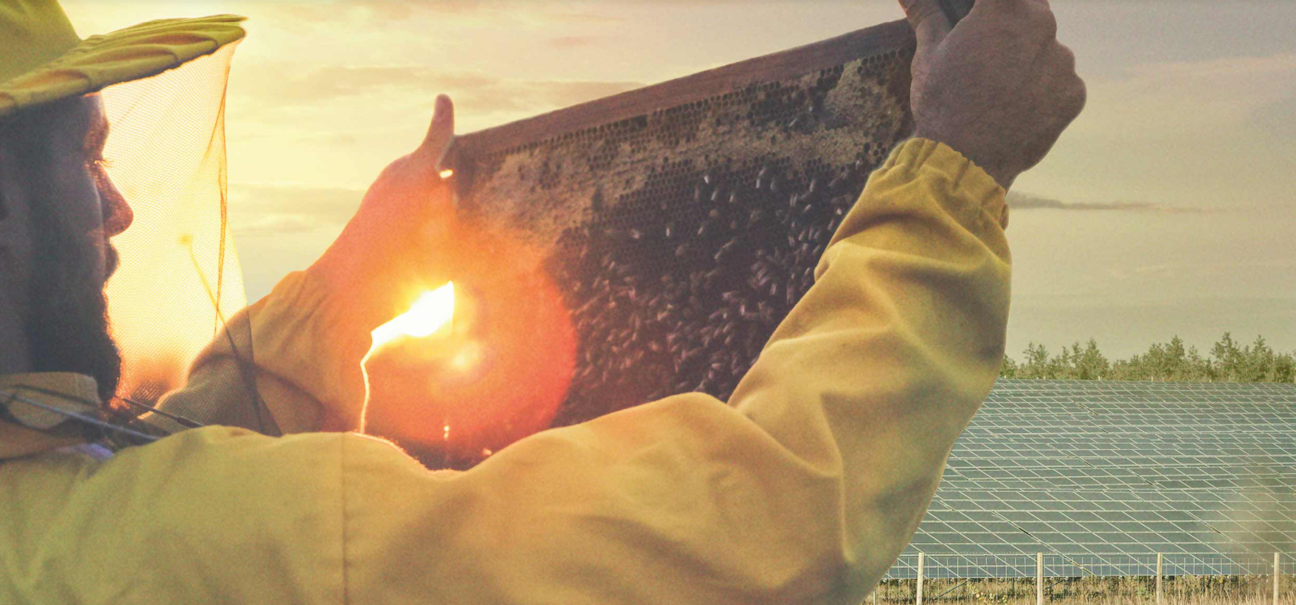
Bees on an Agri PV project (Source:Endesa)
Endesa’s initiative generates shared value with the community by optimising coexistence and collaboration between the agricultural and livestock sector and renewable plants.
The initiative, promoted by the Enel group, englobes five pilot projects on the solar plants of Carmona (Seville), Totana (Murcia), Valdecaballeros and Augusto (Badajoz) and Andorra (Teruel).
These projects include both crops, photovoltaic panels and bees!
Viticulture Agrivoltaics in France by Sun’Agri
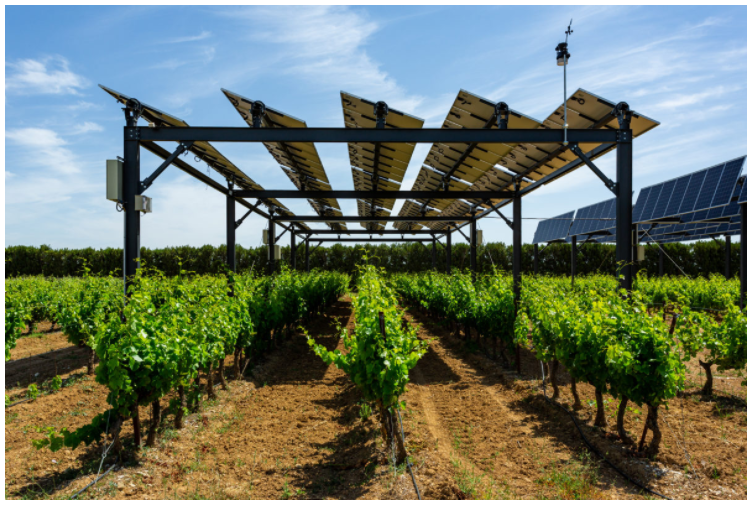
The plant was set up in the wine-growing area in Piolenc, in Hérault, as part of a program to test how agrivoltaics perform in specific crop cultures. For the pilot program, 600m² out of 1,000m² of vines planted were covered by their dynamic agrivoltaic system.
As a result, water demand was reduced by 12-34% for the PV-sheltered vines thanks to a reduction in evapotranspiration. Additionally, the aromatic profile of the grape was improved in the agrivoltaic set-up, with 13% more anthocyanins – red pigments – and 9-14% more acidity.
Sheep and solar in Greece by Enel
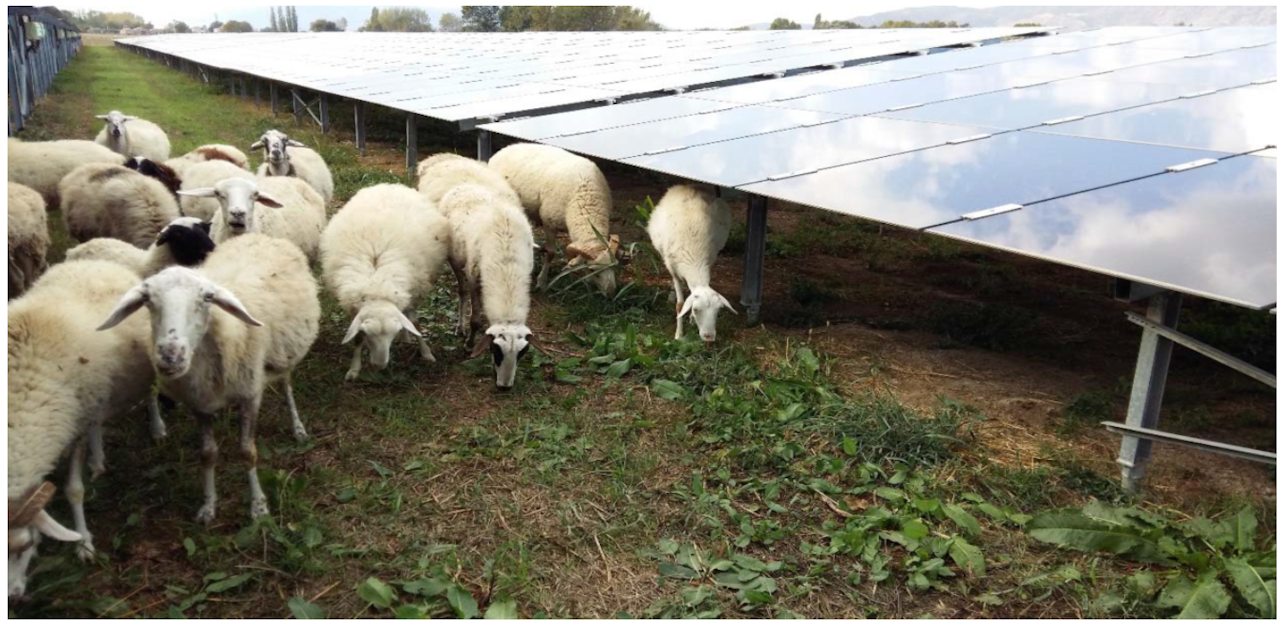
As an example of plants that benefit from farm activities is the plant of Pezouliotika in Greece. This plant was not designed for agrivoltaics specifically, but the co-location of both activities has been profitable for both activities since 2016, when Enel started using sheep to ensure that grass and other plants didn’t interfere with the functioning of the solar panels.
In Greece, the use of sheep has been adopted at installations all over the country. They include five at Xanthi in Thrace in the north-east: Polysitos I and Polysitos ΙΙ, Pezouliotika, Herodasos and Sounio, and another in Thrace, Ιasmos (Rodopi).
This best practice also meant less damage to the solar panels and lower operating costs. By keeping vegetation under control, the solar plant becomes a natural firebreak, helping prevent the spread of a fire, should one break out in a neighboring area. It also leads to the saving of fuel that would be needed for mechanical cutting and avoids the use of chemical herbicides that can cause pollution of both the soil and water resources.
University of Science and Technology of China
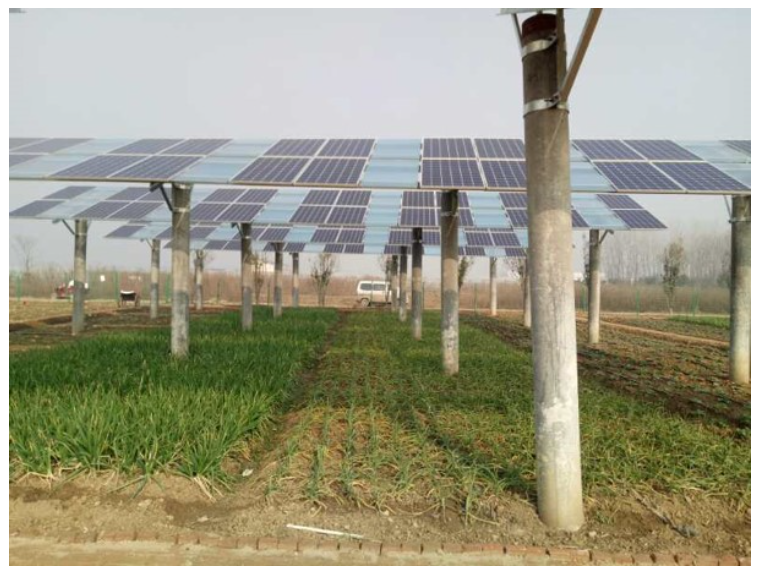
Other technologies favour crop production by analysing different, taller structures.
A group of researchers from the University of Science and Technology of China has developed a special design for agrivoltaic projects that, compared to other approaches, is claimed to reduce the shading effect of the PV installation and improve crops’ light environment and the crop growth process, yield and quality
“The system has a cost that is 10% higher than conventional agrivoltaic project, but the improved crop yield ensured by the optimized lighting management would compensate for this slightly higher investment,”
Have you also developed an agrivoltaic project? Tell us about it and we will add it to our list gladly!
Does your country promote these projects?
Reach out if you want to know more about Agri PV and how RatedPower may help you in the design of these projects.
Latest stories
Related posts
Technology and engineering
Innovation in renewable energy: Developments expected in 2025
We look at the 10 biggest renewable industry developments that are making a green future possible, including perovskite solar cells, green hydrogen, and more.
Updated 18 MAR, 25

Technology and engineering
What the future holds for the longevity and efficiency of solar panels
Tests done by the French photovoltaics group Hespul showed that the panels, installed in 1992, are still operating at an astonishing 79.5% efficiency. Read on to find out more.
Updated 4 MAR, 25
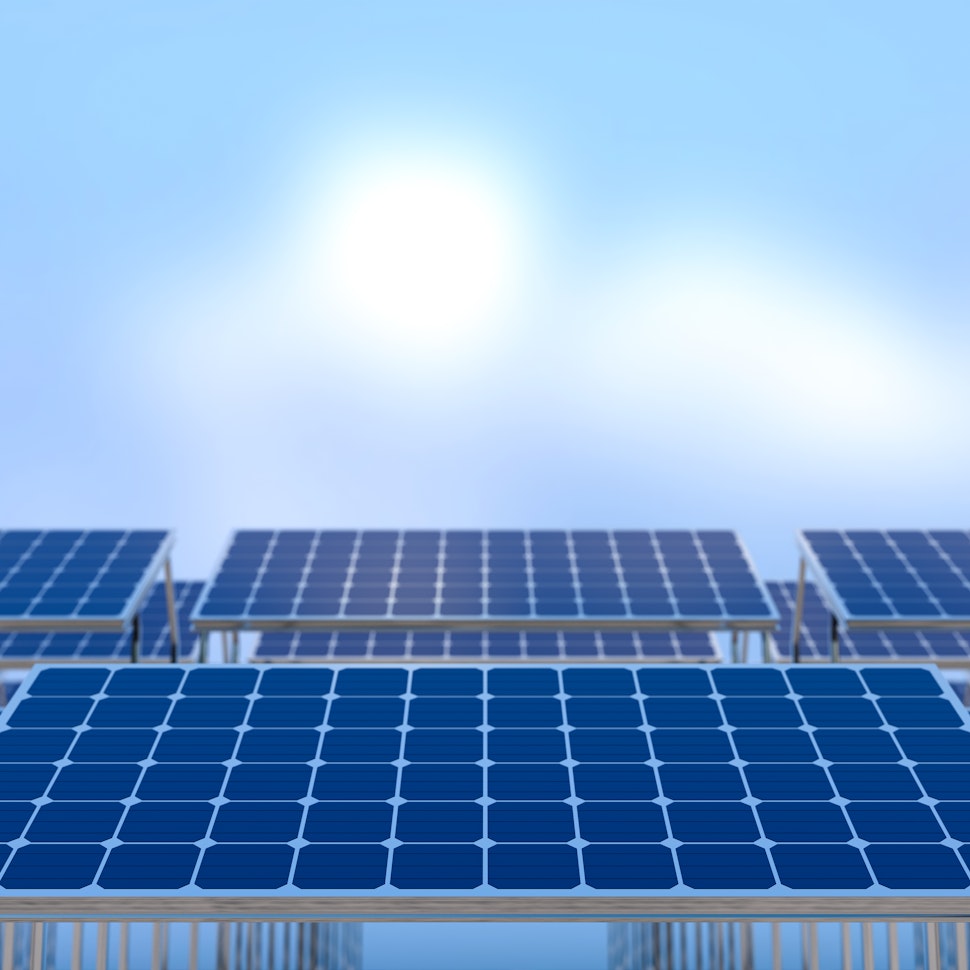
Technology and engineering
Concentrated solar: An unlikely comeback?
Once described as obsolete, the concentrated solar power market ballooned to $53 billion in 2023 and is still growing. Here’s why CSP is making a comeback.
Updated 12 NOV, 24

- RatedPower
- Solar energy blog
- Benefits of Agrivoltaics and 5 real-life examples of successful implementations
